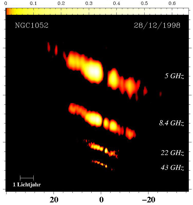|
Eduardo Ros: Supermassive Black Holes
- AGN jets / “Feeding“ of the Supermassive BH
- Merging Galaxies / SMBH Binaries
- AGN feedback / clusters of galaxies
Super massive black holes (SMBH) are believed to lurk at the centre of active galactic nuclei (AGN), which are present in at least 10% of all galaxies in the Universe. Those AGN reveal themselves by an enormous output of energy (from radio to gamma-rays or even TeV, see Figure 1 for a recent example). While non-active galaxies principally emit thermal radiation based on stellar processes, the main radiation of active galaxies is of non-thermal origin. The radiation from the AGN is most likely caused by accretion of mass onto the SMBH. In this process, part of the gravitational energy is converted into heat and electromagnetic radiation and can be detected across the electromagnetic spectrum. The accretion disk and the BH act to form narrow beams of energetic particles and magnetic fields in opposite directions perpendicularly from the disk and away of the BH-disk complex (see Figure 2). These jets emerge at nearly the speed of light and some may extend over millions of light-years, like in the case of FRII jets. They radiate over the entire electromagnetic spectrum with brightness variability on a wide range of time.
 Figure 1 - The gamma-radio sky (background) and several selected AGN jets from the MOJAVE programme. The neighborhood of super-massive black holes hosts the most energetic phenomena of the universe throughout the electromagnetic spectrum. Collage: M. Kadler (images by the Fermi/LAT group and the MOJAVE collaboration) Figure 1 - The gamma-radio sky (background) and several selected AGN jets from the MOJAVE programme. The neighborhood of super-massive black holes hosts the most energetic phenomena of the universe throughout the electromagnetic spectrum. Collage: M. Kadler (images by the Fermi/LAT group and the MOJAVE collaboration)
Detailed studies of jets have so far only been possible in the radio and optical regimes. A combination of observations at all wavelengths, but especially in the radio frequency and at high energies, is necessary to develop a full understanding of the nature of jets. The study of gravitational waves can also help to understand the merging of binary SMBHs. Complementarily, numerical simulations of those magnetized, relativistic plasma streams help to understand the underlying physics and even link their properties to those of the central regions of the active galaxy, in the vicinity of the SMBH.

Figure 2 - Very-long-baseline images of the parsec scale twin jet in the active galaxy NGC 1052, at different wavelengths. The linear scale is in milliarcseconds. Image: M. Kadler et al.
The Working Group No. 4 will develop new strategies and joint forces to study these objects, including observations throughout the spectrum and numerical simulations. We will focus on three main areas: i) SMBH feeding from the accretion disk and its relationship with the observed jets; ii) merging galaxies and SMBH binaries; and iii) evolution and feedback in clusters of galaxies. Possible deliverables such as a concept for newer observations and the need for new instruments, a book summarizing the present state of knowledge in this topic, etc., will be discussed in the group.
|
 Figure 1 - The gamma-radio sky (background) and several selected AGN jets from the MOJAVE programme. The neighborhood of super-massive black holes hosts the most energetic phenomena of the universe throughout the electromagnetic spectrum. Collage: M. Kadler (images by the Fermi/LAT group and the MOJAVE collaboration)
Figure 1 - The gamma-radio sky (background) and several selected AGN jets from the MOJAVE programme. The neighborhood of super-massive black holes hosts the most energetic phenomena of the universe throughout the electromagnetic spectrum. Collage: M. Kadler (images by the Fermi/LAT group and the MOJAVE collaboration)